Australian war memorial movement began before war ended
THE impact of World War I on Australians is reflected in the war memorial movement which started before the war had even ended. Many of the memorials that dot our suburbs and towns came from that sad time.
Central Coast
Don't miss out on the headlines from Central Coast. Followed categories will be added to My News.
- St Paul’s Kincumber celebrates 175th anniversary
- #snapcoast: How to take better pictures of your kids
- SES: Be prepared for a tsunami
WHEN noise and movement fall quiet in RSL Clubs, public buildings and shopping centres across Australia tomorrow morning, Remembrance Day will be just a year short of it’s 100th anniversary.
Each year on the 11th hour of the 11th day of the 11th month Australians observe one minute’s silence to mark the anniversary of the end of a conflict no living Australian can remember first hand.
While the day originally marked the signing of the Armistice that ended WWI, it has come to be a moment to remember Australians who died or suffered in all wars.

The impact of World War I on the collective psyche of Australians of the time is also reflected in the war memorial movement which was underway even before the war had ended.
Committees were formed to decide what kind of memorial would adequately mark the sacrifice of so many people — a cenotaph, an obelisk, or even a statue.
Some communities chose pillars, cairns, windows, flagpoles, gates, ornamental structures, parks, gardens, or buildings as memorials.

The process did not always run smoothly with emotions running high about what was appropriate.
At Gosford, for example, the Cenotaph is one the oldest and best known memorials in the region and remains a focus of Anzac Day services.
But few people know the saga of how this simple sandstone monument came to be.
It took more than three years, four public meetings, hours of heated committee meetings, design and naming competitions and endless fundraising before it was finally unveiled six years after the war ended.
Many suggestions were put forward — a cottage hospital, a memorial pool, a memorial stone arch or a memorial hall, even a chiming clock. One by one each idea was rejected.
The pool was considered by grieving families to be too frivolous for a memorial to the fallen. The hospital idea was liked by many but the ongoing costs made it impossible.
The memorial stone arch plan fell over when nobody could be found to design it, and when a design was finally found, it was too expensive.

The movers and shakers of the district at the time served on the memorial committee — many of whose names are now remembered in the well known Central Coast place names like Adcock Park (Garnet Adcock) Kibble Park (James Kibble) Renwick Street (Arthur Renwick) and Henry Parry Drive.
A public meeting in May 1923 finally adopted much scaled down plans for the cenotaph that now stands in City Park at Gosford — a 5.5m high column of stone cut from Gosford Quarry.
On the western face, the names of those who served, and on the eastern face the symbol of the rising sun.

Building started in November 1923 and the monument was finally unveiled on Anzac Day 1924 by Brigadier General Alexander Jobson. As the flags fell away. The Last Post sounded.
The funds to pay for the memorial were raised mostly by Red Cross women volunteers and returned soldiers.
Gosford RSL branch member Dr Richard G Van Wirdum wrote a detailed history of Gosford War memorial which is held by Gosford Library and can be downloaded.

LONG WAIT FOR WOY WOY
Woy Woy War Memorial was paid for by public donations and though it was unveiled by Brigadier General Alex Jobson on Anzac Day 1925, it was not officially dedicated for another seven years.
It was customary at the time for war memorials to contain a “war trophy” — for example a captured enemy canon.
Bureaucracy almost sabotaged this for Woy Woy, which was offered a German machine gun which was rejected by the Erina Shire Clark in 1920.
By the time the cenotaph was ready the NSW War Trophy committee had run out and a “trophy” had to be sourced from elsewhere.

FIRST DEATH SPURS KINCUMBER COMMUNITY
After being informed of the death of the first local man (Lance Corporal Lansdowne in April, 1918) the local progress committee decided to build a memorial. The first public meeting regarding this subject was held on June 8, 1918.
The memorial is in the grounds of Kincumber Public School fronting Avoca Drive.
The obelisk was constructed of Parramatta sandstone in 1919 with white marble tablets inset detailing those who enlisted from the Kincumber area, together with dates and events of the ‘Great War’.

ERINA MEMORIAL MOVED ON
Erina War Memorial was originally erected to commemorate those who lost their lives in World War One.
An additional plaque has been added to the memorial to commemorate those served in World War II, Korea and Vietnam. Originally the memorial stood beside the The Entrance Road and Terrigal Drive junctions.

It recorded the names of local men who died during World War I and was built using local labour.
The reinforced concrete memorial was moved to the grounds of the Salvation Army Woodport Citadel on The Entrance Road in 1985. It was rededicated in August 1986.
A feature of the original memorial, which vanished over time, was a captured German machinegun.
The Erina District War Memorial was unveiled by Colonel Vernon, D.S.O. in 1923, in the presence of about a thousand people.
The memorial tablet bears the names of soldiers from Erina, Matcham, Wamberal, and Terrigal districts, who fell in the great war.

